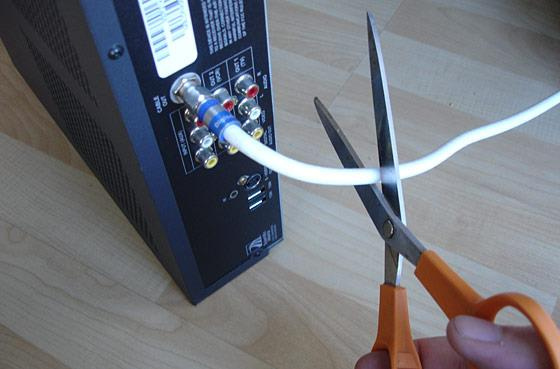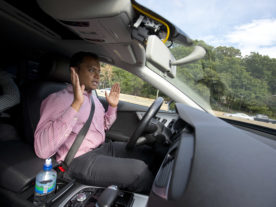
More and more Americans are cutting the cord. (Flickr
Alyssa & Colin)
For decades, most Americans got their television service from cable, but as with many other aspects of life, the Internet is changing that very rapidly as Americans “cut the cord” from their cable providers, opting instead for streaming services.
According to a recent Pew Research Center study, 61 percent of young, so called millennial Americans aged 18 to 29 watch video content via a streaming service as opposed to cable. Overall, Pew found 59 percent of Americans still watch TV over cable, compared to 29 percent who use a streaming service.
It’s not just new cutting-edge streaming services that Americans are turning to, as many are buying relatively inexpensive digital antennas that allow free viewing of many digitally broadcast stations, including the major broadcast networks.
The pace of cord-cutting is picking up, according to a recent report from eMarketer, which predicted 22 million Americans will cut the cord this year.
“Younger audiences continue to switch to either exclusively watching [streaming] video or watching them in combination with free TV options,” said Chris Bendtsen, senior forecasting analyst at eMarketer. “Last year, even the Olympics and presidential elections could not prevent younger audiences from abandoning pay TV.”
Some say millennials eventually will go back to cable.
“We think behaviors could change once the so-called millennials start having families,” said Glenn B. Enoch, senior vice president for audience insights at Nielsen in an interview with The New York Times. New parents’ desire for better programming for their children will help drive them to cable, media executives have predicted.
Millennial Budgeting
One major reason for cord-cutting is to save money as people view cable as too expensive, often costing more than $100 a month. And while cable companies offer hundreds of channels to choose from, many just want access to a few channels.
Some say that once you subscribe to several paid streaming services, however, the savings aren’t that much.
“You’re going to see consumers who look at those packages and realize a smaller package is going to ultimately not hitting all buttons they want to hit,”said Ian Olgeirson, an analyst with the Kagan division of S&P Global Market Intelligence in an interview with the Los Angeles Times newspaper. “We’re entering a phase of more choice, but not one in which consumers have ultimate leverage.”
Other drivers
But cost is not the only driver.
“The acceleration of cord-cutting is the result of several factors,” said eMarketer principal analyst Paul Verna. “First, traditional pay TV operators are increasingly developing streaming platforms, such as Dish Network’s Sling TV.
“Second, networks such as HBO and ESPN have launched standalone subscription services that allow users to tap those channels without a cable subscription,” he said. “And third, digital players like Hulu and YouTube are now delivering live TV channels over the internet at reasonable prices — including sports properties that were previously available only through traditional distribution.”
Another driver is that Americans are spending less time in front of the traditional TV overall, with Americans watching, on average 3 hours and 58 minutes of TV a day, according to eMarketer, which added it is the first time that number has dipped below four hours a day. Time watching digital videos increased to one hour and 17 minutes, up 9.3 percent over 2016, eMarketer said.
Fractured Audience
The shift affects how Americans get their news and entertainment. Not long ago, American television viewers generally got their news and entertainment from one of three broadcast television stations. Today, Americans get news and entertainment from literally thousands of sources, and the list of content providers is growing.
Earlier this year, Apple announced it was going to spend $1 billion on developing original programming next year. HBO, Amazon, Netflix and others are already at it.
“Now with Netflix and Hulu and Amazon and all these other players, and Apple coming into the fray, you’re not going to watch all that stuff, Recode Managing Editor Edmund Lee told CNBC, “There’s going to be different audiences for different shows. That’s what we are seeing. There’s a bit of a fracturing of the audience.”
A fractured audience may not be problematic when it comes to entertainment, but there are signs fractured news audiences are leading to political polarization.
“When it comes to getting news about politics and government, liberals and conservatives inhabit different worlds,” Pew wrote in a 2014 study on the effects of media habits and polarization.
Cord-cutting may deepen the divide.
“The internet, for example, is now closing in on television as a source of news in the U.S.,” Pew wrote. “A generation ago, television was far and away the dominant news source for Americans, but now, the internet substantially outpaces TV as a regular news source for adults younger than 50.”
























